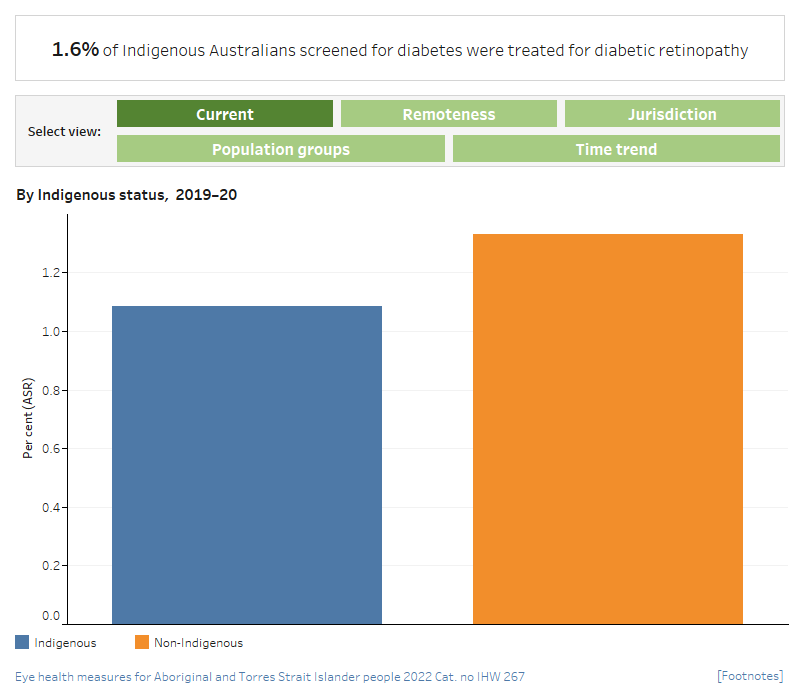Treated for diabetic retinopathy among those tested for diabetes
Measure 3.7.2: The diabetic retinopathy treatment rate, expressed as the number of Indigenous Australians who had a retinal laser procedure or an intra-vitreal injection who had also had a diabetes test as a proportion of those who had a diabetes test. Indigenous Australians who had a diabetes test may not have been found to have diabetes. For this reason the rate of those treated for diabetic retinopathy may be an underestimate.
The timely treatment of diabetic retinopathy can prevent vision loss. Treatment generally involves injections into the eye or laser therapy.
Figure 3.7.2: Treated for diabetic retinopathy among those tested for diabetes
There are 5 separate charts for this measure by various characteristics.
Age standardised proportion of Indigenous Australians screened for diabetic retinopathy treated for diabetic retinopathy by Indigenous status, 2019─20
This vertical bar chart compares the age-standardised proportion of the population screened for diabetic retinopathy who received treatment in 2019–20, by Indigenous status. The age-standardised proportion was 1.1% for Indigenous Australians and 1.3% for non-Indigenous Australians.
Proportion of Indigenous Australians screened for diabetic retinopathy treated for diabetic retinopathy by region, 2019─20
This dual axis combined vertical bar chart and scatter plot displays the proportion and number of Indigenous Australians screened who were treated for diabetic retinopathy in 2019─20, by remoteness status. Point markers display the proportion treated in each remoteness area. The proportion is highest in Major cities (1.9%) and Inner regional and Outer regional areas (both 1.8%), and lowest in Very remote areas 0.6%).
Proportion of Indigenous Australians screened for diabetic retinopathy treated for diabetic retinopathy by jurisdiction, 2019─20
This dual axis combined vertical bar chart and scatter plot displays the proportion and number of Indigenous Australians screened who were treated for diabetic retinopathy in 2019─20, by jurisdiction. Point markers display the proportion treated in each jurisdiction. The highest number treated is in New South Wales (239), but the highest proportion is in the Australian Capital Territory (2.2%). The lowest number treated was in South Australia (16), but the lowest proportion was in the Northern Territory (0.2%).
Proportion of Indigenous Australians screened for diabetic retinopathy treated for diabetic retinopathy, by age and sex, 2019─20
The grouped vertical bar chart displays the proportion of Indigenous Australians screened who were treated for diabetic retinopathy in 2019–20 by age group and by sex. The rate increases with age for males and females across all age groups. The rate for males is higher in all age groups except 65+ years.
Proportion of Indigenous Australians screened for diabetic retinopathy treated for diabetic retinopathy 2010─11 to 2019─20
This dual axis combined line chart and scatter graph shows the proportion of Indigenous Australians screened who were treated for diabetic retinopathy, from 2010─11 to 2019─20. Point markers display the percentage treated, while the line displays the number treated in each time period. The proportion increased from 1.3% in 2010–11 to 1.6% in 2019–20, as did the number receiving treatment going from 351 to 506.

- In 2019–20, there were 506 Aboriginal and Torres Strait Islander Australians screened for diabetes who underwent treatment. This was 1.6% of those screened for diabetes. The age-standardised proportion of those treated was lower for Indigenous (1.1%) than for non-Indigenous Australians (1.3%).
- Between 2010–11 and 2019–20, the estimated proportion of Indigenous Australians screened for diabetes who underwent treatment rose from 1.3% in 2010–11 to 1.6% in 2019–20. The number screened increased from 26,713 to 32,000 over this same time-period.


